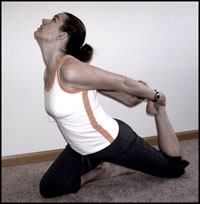 So, what does courage tempered by wisdom look like? How is it different from the kind of courage that prompts our friends to say “You’re so brave!” when what they’re really thinking is “You’re so out of your mind!” Yoga set me on a path of awareness and self-discovery. As I’ve walked along this path, I’ve learned the value of doing things that make me uncomfortable. When I am uncomfortable, and I push myself to be in the moment and experience the discomfort rather than run away from the uncomfortable experience, I grow. And I learn a little something about myself.
So, what does courage tempered by wisdom look like? How is it different from the kind of courage that prompts our friends to say “You’re so brave!” when what they’re really thinking is “You’re so out of your mind!” Yoga set me on a path of awareness and self-discovery. As I’ve walked along this path, I’ve learned the value of doing things that make me uncomfortable. When I am uncomfortable, and I push myself to be in the moment and experience the discomfort rather than run away from the uncomfortable experience, I grow. And I learn a little something about myself.
This past weekend I threw myself into the uncomfortable end of the pond. I swam for all I was worth. My motto this weekend was, “Play big or go home.” (more…)




